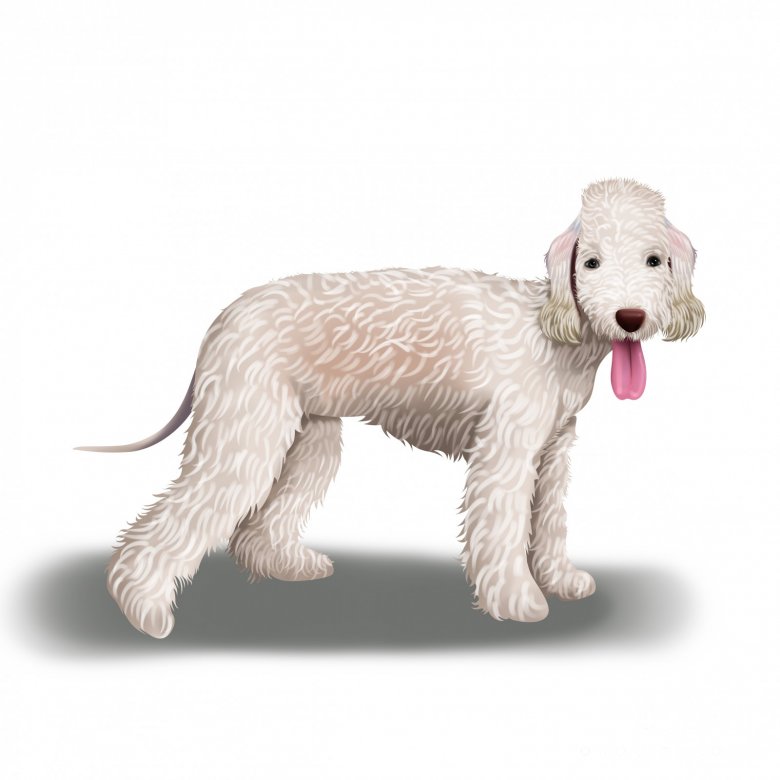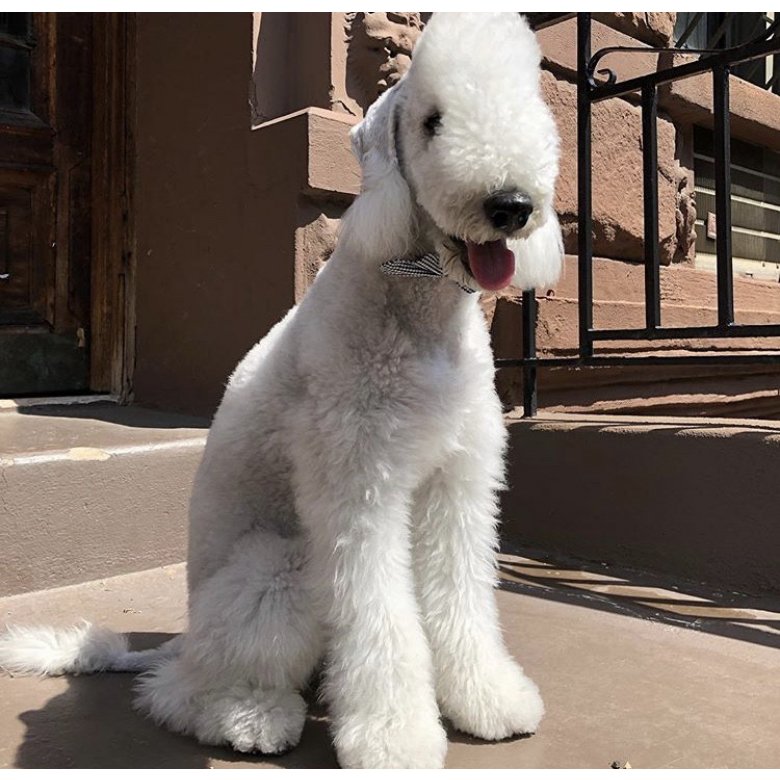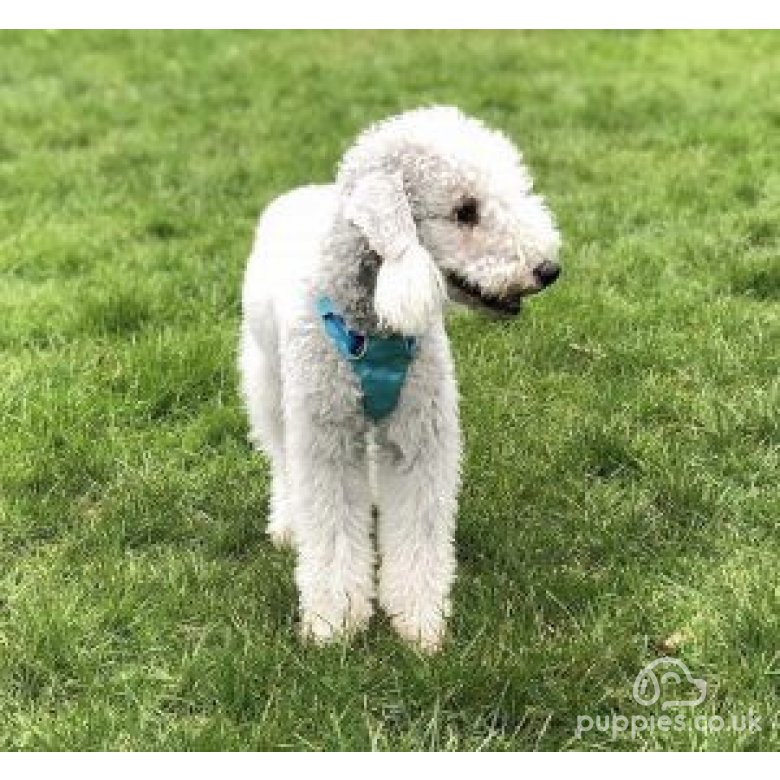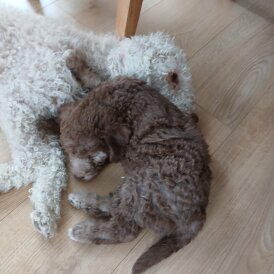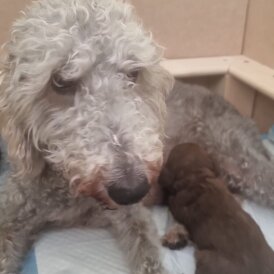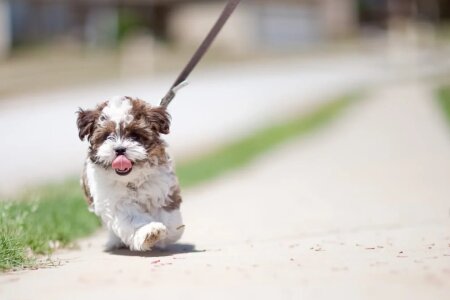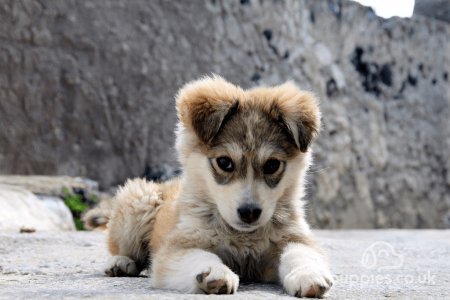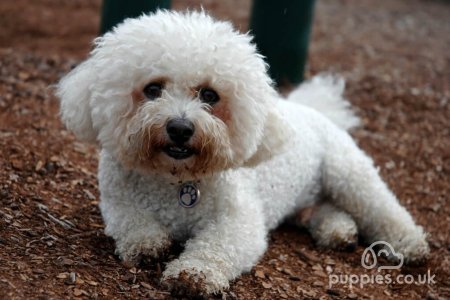Geordies are known for being friendly, sociable, and warm-hearted in spite of the cold Northeast winters. Why Aye! So too are their favourite canine companions, the lamblike Bedlington Terrier. Their unique appearance is sure to turn heads and they’re simply adorable as puppies. Not only are Bedlington Terriers beautiful but they’re also loving companions that get along well with children and the elderly. As a terrier breed, Bedlington Terriers are typically spirited and game yet they tend to be more mild-mannered and better behaved indoors than many other terrier breeds. There are so many great reasons to consider purchasing a Bedlington Terrier puppy with their great qualities and appearance amongst the top reasons.
Why Bedlington Terriers are Great
Some highlights of Bedlington Terriers:
Adaptable: this small breed can live comfortably in many climates and fares well in apartments and homes alike.
Indoors living: when compared with most other terrier breeds, Bedlington Terriers tend to behave better indoors.
Affectionate: this mild-mannered breed is gentle and loving with owners and their families.
Elderly owners: Bedlington Terriers are exceptional companions for the elderly.
Appearance: Bedlington Terriers have a unique appearance that resembles a small lamb, making them a beautifully diverse breed.
Things to Consider when Looking at Bedlington Terriers for Sale
Some downsides to the Bedlington Terriers:
Isolation: as with many terrier breeds, Bedlington Terriers don’t like being left alone and can quickly become bored, thus leading to destructive behaviour.
Grooming: this breed requires a fair bit of professional grooming in order to keep healthy and beautiful.
Barking: some Bedlington Terriers have a tendency to bark frequently and to howl.
Digging: if allowed to play in the garden unsupervised, Bedlington Terriers can dig up flowerbeds and make a mess of the garden.
History of the Bedlington Terrier
Terriers have a rich history in Britain, being used in centuries past to catch game on rural estates. Named after the mining town of the same name, the Bedlington Terrier gained popularity in the 19th century for its super ability to catch vermin, first on farms and estates and later in mining towns and villages that proliferated around Newcastle upon Tyne during the Industrial Revolution. Lord Rothbury was passionate about this breed and worked hard to promote their breeding in Northumberland. Originally, it was referred to as the Rothbury Terrier or the Northumberland Terrier. The name Bedlington Terrier came about later in the 19th century when breeder Joseph Aynsley from Bedlington adopted and promoted their breeding. The breed was introduced to a wider audience after its initial showing at a Newcastle dog shop in 1879. Subsequently, they gained some popularity across Britain and worldwide, but it was not until 1948 that the Kennel Club of Great Britain recognised the breed. They remain a well-loved breed to this day despite their rarity.
Appearance
Bedlington Terriers are immediately recognisable by their appearance. They have long heads, arched loins, and linty coat of fur and therefore resemble lambs. In terms of physique, they are graceful yet muscular. This breed comes in many colours, with a lamblike white being the most famous. Puppies tend to have darker colours which lighten over time, so don’t worry if your desired white Bedlington Terrier isn’t white enough as a puppy. Liver and sandy colours will lighten as the puppy ages.
How big is the Bedlington Terriers?
Bedlington Terriers are small-sized dogs. Males grow on average to 41–44 cm in height, whilst females can grow up to 38-42 cm high.
How heavy is a Bedlington Terriers?
Fully-grown adult male and female Bedlington Terriers weigh between 7.7-10.4 kg on average.
What colour is the Bedlington Terriers?
This breed has the following commonly-accepted coat colours:
Tan-coloured hair can complement any of the above three main colours. Dark pigmentation is encouraged. Bedlington Terriers tend to have darker-coloured coats of fur as puppies which lightens over time, producing in many a signature white colour.
Temperament
Bedlington Terriers may be small, but they more than make up for their size with spirit and confidence. As puppies, they are surprisingly easy to train and therefore make a great choice of puppy for first time owners. Care and attention given to young Bedlington Terriers will pay off in spades since they are also affectionate companions, particularly for the elderly. Although bred to catch vermin such as rodents in towns and mining villages in Northumberland, they are now better adapted to domesticated indoor environments. Nevertheless, Bedlington Terriers still retain a high prey drive and are capable of running and dashing at incredible speeds. Furthermore, their rodent-catching instincts still remain as they are prone to digging up flowerbeds and gardens if left unsupervised.
Do Bedlington Terriers make good guard dogs?
Bedlington Terriers do not make good guard dogs since they are rarely aggressive and can be timid around strangers. They do, however, make excellent watchdogs since they will be quick to alert owners of any suspicious activity.
Do Bedlington Terriers bark a lot?
This breed barks and howls often if left unchecked. From a young age, ensure that puppies are taught discipline and obedience so that their barking and howling don’t go out of control. The sound of their barking may be annoying to owners, so consider rigorous training to reduce bad habits.
Are Bedlington Terriers easy to train?
Although Bedlington Terriers are intelligent and can be trained fairly easily, they are true terriers and show typical signs of stubbornness at times. Positive reinforcement is key with this breed since they’re intelligent and sensitive. Teach them obedience and good behaviour and reward them, but avoid spoiling them as puppies.
Are Bedlington Terriers playful?
This breed enjoys playing frequently, especially as puppies. They do tend to be slightly calmer than other terrier breeds, however.
Are Bedlington Terriers good with children?
Bedlington Terriers tend to get along better with older children than younger children. Toddlers should never be left unsupervised whilst playing with the puppy since they are sensitive and may become boisterous or nip.
Are Bedlington Terriers good with other pets?
Generally, Bedlington Terriers get along well with other pets indoors provided that they’ve been introduced gradually. Animals outdoors may find themselves chased around since Bedlington Terriers have a high prey drive.
Can I leave a Bedlington Terrier alone?
This breed tolerates being left alone for small amounts of time. Extended periods of isolation can lead to boredom and destructive behaviour, so this breed is recommended only for owners that are willing to spend plenty of time with them.
Do Bedlington Terriers like water?
Most Bedlington Terriers are avid swimmers that love being in the water. All puppies should be introduced to water on their own, however. Allow them to dip their paws into water before letting them go for a swim so that they don’t become frightened of the water.
Health
How long do Bedlington Terriers live?
Generally, Bedlington Terriers are expected to live anywhere from 12-14 years with an average of about 13.5 years.
How much exercise does a Bedlington Terrier need?
This breed requires a fair amount of exercise. Spend about an hour a day taking him out for a walk and allow some time off the lead, but always maintain supervision.
What are a Bedlington Terrier’s common health issues?
Bedlington Terriers are prone to the following common health issues:
Reproductive problems;
Heart murmurs;
Epiphora;
Retinal dysplasia;
Cataracts;
Copper toxicosis.
Care
How much space do I need for a Bedlington Terrier?
Bedlington Terriers are able to live comfortably in small and large homes alike and are ideal for urban environments. Although they can live comfortably in apartments and are excellent indoor pets, they should be taken outside daily for exercise and fresh air.
What should I feed my Bedlington Terriers?
A fully-grown Bedlington Terriers should be fed 1 to 1.5 cups of high-quality dog food every day, divided into two meals. Puppies should be fed a little less than this. Adjust as necessary to promote good health and to prevent overfeeding.
How much grooming do Bedlington Terriers need?
This breed has fairly high grooming requirements. They should be professionally groomed at least once every two months. Ensure that their ears are inspected to avoid infections.
Do Bedlington Terriers shed?
This breed doesn’t shed much hair and as such is a reasonably attractive puppy choice for allergy sufferers.
Average Costs
How much does it cost to keep a Bedlington Terriers?
As a rough guide in pricing: Cost to buy: roughly £300-500 for a well-bred Bedlington Terriers puppy Other costs (Vet, Food etc): £70-90 per month
Specific Buying Guide
You can read our general buying guide here, with the most important thing being going to view your Bedlington Terrier puppy, seeing it with its mother, and checking the quality of the breeder. More specifically, here is some Bedlington Terrier puppy buying advice:
This breed is quite rare, even in its native Britain. It’s therefore recommended that prospective buyers put in the effort to ensure that the puppy was bred in ethical conditions and meets the Kennel Club’s breeding standards.
Bedlington Terriers are more prone to copper toxicosis, an accumulation of copper in the liver which can lead to death. One in eight Bedlington Terriers die from this disease alone, so bear in mind that chances are high that your puppy won’t live as long as the above stated average.
Other Reading, Adopting Bedlington Terriers Puppies and Rescue Organisations
A big thank you to the following sources who helped to shape this article: Bedlington Terrier Rescue: https://www.bedlingtonrescue.co.uk/ National Bedlington Terrier Club: https://www.rightstartdogs.co.uk/bedlington-terrier-rescue-foundation/ Kennel Club of Great Britain: https://www.thekennelclub.org.uk/services/public/breed/display.aspx?id=3061 UK Dog Trust: https://www.dogstrust.org.uk/ Blue Cross: https://www.bluecross.org.uk/rehome-pet Federation Cynologique Internationale: https://www.fci.be/Nomenclature/Standards/009g03-en.pdf










